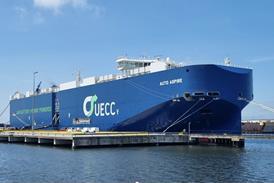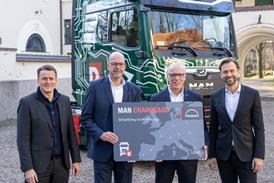
Hit hard in the tough times, but expected to respond rapidly when the economy improves, tier one suppliers must find logistics approaches that are fast, cheap and flexible. Jonathan Ward reports that some are now benefitting from investment in IT and process improvements.
The first tier is a tricky place to be in the automotive supply chain. Tier one suppliers must be able to comply with the precise logistics requirements of their OEM customers, even where these requirements vary significantly from customer to customer. At the same time, they must achieve excellent service levels for every customer while operating under phenomenally tight cost constraints. Moreover, it is usually only the very largest first tier suppliers that have the scale and purchasing power to dictate operating requirements to their own suppliers and service providers.
Working in these punishing conditions has pushed tier one suppliers to focus on the development of highly flexible approaches to logistics management. For many, the dramatic swings in demand and challenging supply chain disruptions of recent years have given these systems the opportunity to demonstrate their true worth.
Felice Patti, manager of international logistics at exhaust system and shock absorber supplier Tenneco, sums up succinctly the logistics challenges for companies in his part of the automotive supply chain.
 “Logistics must be simple, fast and cost effective. But in the end, Tenneco defines the best solution in collaboration with its customers.”
“Logistics must be simple, fast and cost effective. But in the end, Tenneco defines the best solution in collaboration with its customers.”
Tenneco’s approach to logistics is built on a careful combination of central and regional control, combined with a relentless focus on continuous improvement.
“Our logistics processes are organised on a global basis, but managed at a country level,” explains Patti. “Our corporate logistics function operates a ‘standard RFQ’ system under which all our logistics contracts are benchmarked every two years.”
Constantly measuring service provision against the market is one way to drive continuous improvement, but Tenneco works especially hard to evolve its internal logistics practices, and to ensure that good practices are adopted across the entire company.
“Corporate logistics invites all our logistics managers to participate in a workshop every year to discuss business evolution, changes in customers and suppliers, and changes in demand,” says Patti. “We work in different workshop teams to create best practice solutions, based on the experiences of other logistics managers or the corporate logistics team, agree RFQs and reengineering processes with a defined timeline to close and implement the optimised or new processes.”
Global logistics development workshops are supplemented by regional events, which take place once or twice a year in Europe and the US. The result of all this effort, says Patti, is constant change.
“We have no process in place which hasn’t changed over the last five years. And all our existing processes will certainly change more than once over the next five or ten years. All the time we have to adapt our processes to ensure they match the problem we have to solve. We don’t try to adapt the problem to match to our process.”
Parts and processes hand in hand
For mechatronic systems supplier Brose, the ability to customise logistics solutions to suit the specific needs of its OEM customers is a key part of its overall offering.
“As a system supplier of complete mechatronic systems and drives for automobiles, we do more than supply our customers with products and components with the necessary engineering performance. Our solutions also include supply chain convenience,” explains Dr Thomas Böger, who has been the group’s vice president of logistics since 2004. “This begins even before the customer project is signed–we develop a logistics concept tailor-made to the customer’s requirements during the acquisition phase of a new project.”
 Brose has a policy of maximising local sourcing wherever possible and this philosophy extends to its logistics capabilities, says Böger. “We have local logistics experts, who are trained on the specific Brose tools, systems and processes within our organisation. The operative business in logistics is managed locally according to the needs of the specific supply chains. Each location is fully responsible for day-to-day operations.”
Brose has a policy of maximising local sourcing wherever possible and this philosophy extends to its logistics capabilities, says Böger. “We have local logistics experts, who are trained on the specific Brose tools, systems and processes within our organisation. The operative business in logistics is managed locally according to the needs of the specific supply chains. Each location is fully responsible for day-to-day operations.”
To be successful, however, this local approach must be combined with a mechanism to maintain company-wide standards and facilitate the exchange of best practices. “When it comes to coordinating and defining global and regional standards, processes, tools and guidelines for the group, we have a centralised organisation with overall, functional, groupwide responsibility,” says Böger. “One of the organisation’s constant main targets is to improve the communication channels to ensure that know-how, experience, best-practice solutions, etc. are shared between the different functional logistics areas within the organisation.”
An important example of this central coordinating function, says Böger, is the company’s IT infrastructure.
“Our logistics structure is supported by one standard worldwide IT system,” he says. “This means we are able to run the logistics processes at all our locations around the world in the same way. This helps to standardise the processes, enables us to set up new locations with a reasonable amount of effort, and ensures that we have the necessary cost and process transparency to manage our supply chains.”
In practice, Böger points out that it is a tightly coordinated, two-way process between the company’s central and local logistics functions that delivers the right balance of performance and cost effectiveness in its processes. “A service provider consolidation project, for example, starts with a detailed data analysis. This will be done by the central team in consultation with the locations to be sure that the correct planning basis is available,” he explains. “Based on this data, a concept is drawn up and agreed internally. In a next step, the concept is sent out to the service provider on the market for a quotation. After a discussion that aims to cover all the different solutions, the team comes to a final decision and the project can be implemented. During the whole process there is also close cooperation between the logistics and the purchasing departments.”
Finally, says Böger, it is essential that the company closes the loop to check that changes to its logistics processes are delivering what they promise.
“A very important aspect is the follow-up meeting after implementation of the processes to be sure that the original concept is still up to date.”
Tight integration between manufacturing and logistics is something that many of the tier one suppliers we spoke to were keen to emphasise. Most run supply-in-sequence operations adjacent to various customer plants, which rely on the ability to closely couple manufacturing expertise with slick logistics.
At Brose, for example, Böger points to the example of the company’s door systems as a complex product requiring sequenced assembly and delivery. The company’s justin- sequence factory in Sindelfingen, Germany relies on “best-practice manufacturing, a newly developed paperless production control system–called e-production–and rigorous implementation of the ‘Brose Productivity System’,” he says.
The plant also has a “transparent shop floor management system with employee involvement”, which allows it to adapt continually to changing customer needs and to increase competition. The plant, which recently won a Manufacturing Excellence Award, is now a benchmark for other facilities in the group.
At Eberspächer, another manufacturer of exhaust systems, tightly integrated production, logistics and IT systems are considered a critically competitive advantage. Efficient logistics are particularly important for exhaust components thanks to the large size of the main components in comparison to their value, explains Hermann Hinck, vice president of global logistics for the company’s exhaust technology division. As more of Eberspächer’s customers move to global vehicle platforms, the company is finding that its component supply chains are increasingly becoming global, with large flows of components between Europe and plants in South Africa and the US, for example.
At the centre of Eberspächer’s logistics approach is a single IT platform–based on the SAP system–that runs all its operations worldwide.
“We began implementing the system ten years ago, completed its roll out in all our European plants in 2006, and this year we will fully integrate our plants in South Africa, too,” explains Hinck. The aim of the system, he says, is to “see the complete supply chain from supplier to customer in one view. We have a 24-hour a day, 365-day link via EDI to our customers, so if the customer changes its demand, our plants will see that change an hour later, wherever they are in the world and we can give the same information to our own suppliers, if they need it.”
 This visibility obviously helps Eberspächer to run its dayto- day operations smoothly, but the system also provides a foundation for longer-term development.
This visibility obviously helps Eberspächer to run its dayto- day operations smoothly, but the system also provides a foundation for longer-term development.
“Besides our operational data, the system also contains long-term planning data for the next four to five years, allowing us to plan the capacity changes we will need to make in response.”
The ability of modern integrated logistics and production IT systems to bring together all the data required to run a supply chain and make modifications to it proved extremely useful to Eberspächer during the downturn of 2008.
“During the crisis we built a KPI system which gave us daily demand and capacity indicators for the coming weeks and months,” explains Hinck. “We were able to react very quickly to changing demand, by introducing shutdown days, and adjusting our employees’ hours to ensure we matched demand as it fell.”
The early warning system introduced during the crisis proved equally useful as demand began to rise rapidly during the recovery, says Hinck, allowing Eberspächer to ramp up production quickly and smoothly.
“We have been able to make some very quick changes, like moving machines from one plant to another to ensure we have the capacity we need, where we need it.”
Other changes introduced during the crisis are continuing to provide benefits too. The company embarked on a largescale logistics integration programme to move to a single forwarder for all its worldwide l f ogistics activities.
“Our provider can make the best decisions about how to manage transportation, which will lead to big changes in terms of vehicle utilisation and the cost of transporting empty pallets and packaging,” explains Hinck.
Perhaps the most compelling example of the usefulness of Eberspächer’s integrated IT has been the company’s response to this year’s earthquake in Japan, however.
“There are some key components in the early part of our supply chain that come from the affected part of Japan,” explains Hinck. “We quickly identified with our supplier that there was a problem and one week after the earthquake we began working with our original supplier, alternative suppliers and our customers to find a solution. We finalised that solution in mid May and we are now running it as our daily business. Without our IT system, that sort of change just wouldn’t have been possible. The implementation effort was ten years well spent.”
If it is pleased with the performance of its current logistics systems, Eberspächer is not satisfied with them. Hinck is currently deeply involved in the design and construction of the company’s latest plant near Dresden in Germany, which will produce exhaust systems that comply with the latest Euro 6 standards.
“We will manage and launch our new plant in a special way,” he explains “The entire layout of the plant is designed to optimise production processes and logistics, which will be synchronised at all levels. We are running simulations of the complete process so that we can put the best possible logistics parameters into our MRP system. Our overall aim is to double the inventory turns at the new plant, and what we develop here will become the standard for all our production facilities worldwide.”
 Implications for 3PLs For logistics providers, the tier one space is a challenging one to serve, but provides an important opportunity to grab a larger share of supply chain value than is typically offered by OEMs. A single new delivery project for a tier one supplier can include the provision of logistics services that include all modes of transport as well as warehousing. According to Katharina Huth, head of business development of automotive contract logistics at Kuehne + Nagel, the need for tier one suppliers to outline their logistics plans during the process of bidding for new supply costs means a lot of time and effort spent responding to RFQs.
Implications for 3PLs For logistics providers, the tier one space is a challenging one to serve, but provides an important opportunity to grab a larger share of supply chain value than is typically offered by OEMs. A single new delivery project for a tier one supplier can include the provision of logistics services that include all modes of transport as well as warehousing. According to Katharina Huth, head of business development of automotive contract logistics at Kuehne + Nagel, the need for tier one suppliers to outline their logistics plans during the process of bidding for new supply costs means a lot of time and effort spent responding to RFQs.
“We are frequently asked to price scenarios where the OEMs have not yet decided to choose the supplying tier one supplier but, depending on the incoterms, logistics costs have to be priced in. With OEMs it is different, if they send a RFQ they know that this scenario will take place, as they are the ones defining the tier one supplier’s supply chain and logistics requirements.”
The upside of this effort, however, is that tier one suppliers are typically looking to outsource substantial parts of their business. “Tier one suppliers are usually looking for a solution,” says Huth. “Where the OEMs know exactly what they want and are looking to get it at the best price, tier one suppliers come to us to show them how to deliver the service they need. Often they don’t have their own logistics IT systems, for example, so they are keen to use ours.”
Another important trend from the LSP’s perspective, says Huth, is a downstream shift in logistics purchasing responsibility. “More and more of the vehicle manufacturers are recognising that they can benefit from economies of scale by taking control of the logistics from their suppliers to their plants, so we are increasingly contracted with the OEMs to provide those services rather then the tier ones.”
The same logic applies to inbound supply at tier one suppliers, however, with the largest suppliers increasingly bundling their own inbound supply processes into larger logistics contracts.
Tier one suppliers and their logistics providers will face many new challenges–the speed of the recovery in major market such as Germany, for example, is leading to acute labour shortages, pushing up logistics costs, while rising fuel prices are likely to do the same over the longer term. The rapid growth of the BRIC economies is testing their ability to deploy and support new supply chains as well. However, the systems and processes that the manufacturers have built over the past decade or so, which have been so thoroughly stress-tested by recent events, should serve them well in meeting whatever the future holds.































